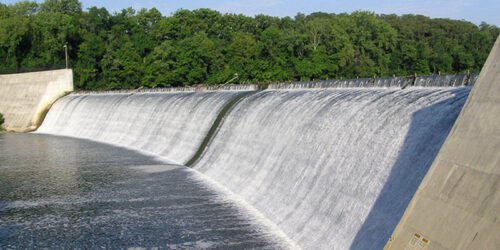The National Transmission and Despatch Company (NTDC) recently submitted the revised Indicative Generation Capacity Expansion Plan (IGCEP) for the regulator’s approval. Alongside other revisions, it indicates an increase in the planned hydropower share to more than half of the country’s total energy mix by 2030.
The hydropower component of the IGCEP displays an ‘alarming trend’, according to the comments on the plan submitted to NTDC by the Rural Development Policy Institute (RDPI), a civil initiative aiming to stimulate public dialogue on policies, and the Alternative Law Collective (ALC), a group of lawyers and academics working for causes having a social impact.
“This model would make future hydropower projects the centrepieces of Pakistan’s energy expansion plan. While this may be good news for the global dam industry, and the relevant government agencies as large-scale infrastructures are good for business, this doesn’t bode well for the citizen, taxpayers and future generations,” the two nonprofits underline in their commentary.
The analysis of the hydropower projects listed in the IGCEP 2021-30 shows that the plan overlooks and hides various technical problems, expected cost overruns, and the social and environmental damages likely to occur. “If these hidden and overlooked costs are included in the planning, most of the hydropower projects do not remain economically feasible. If these challenges are not addressed and the alternatives not explored, the shift to hydropower will worsen the water and environmental crises in Pakistan, increase water distribution conflicts, destroy river and wetland ecology, increase coastal erosion and sea intrusion, and enhance the risk of severe floods that may cause tens of billions of dollars in terms of damages,” the documents submitted to the NTDC argue.
The plan makes hydropower the largest single source of power production with a base generation of 50 per cent followed by 25pc generation from fossil fuel, 13pc from nuclear and 10pc from renewables like solar and wind. In terms of the committed projects, hydropower share is about 60pc. The list of the committed projects shows that NTDC plans to increase generation capacity by 22,180 megawatts by 2030 through 69 projects, with 13,161 megawatts coming through 23 hydropower schemes.
“Most of the hydropower energy will be generated using large dams. At least 10 of the 23 projects involve large dams, including mega dams such as Diamer Bhasha, Dasu, Mohmand and large dams such as Kohala, Suki Kinari, Karot, Azad Pattan, and others.
“While the NTDC report emphasises that the majority of the dams are run-of-the-river with minimal environmental and social costs, 12,718 megawatts, or about 97pc, of new hydropower will come from the large dams that will cumulatively generate.”
The NTDC justifies this shift to hydropower on two arguments: environmental concerns, particularly with regards to climate change; and reliance on indigenous sources of fuel. “But evidence from existing hydropower dams in Pakistan and elsewhere in the world tells a different story,” the RDPI/ALC commentary contends.
“Pakistan’s shift to hydropower signals a number of problems. The proposed hydropower projects will have huge economic cost overruns, will cause environmental damage, are unsuitable for the climate and seismic conditions, and will have adverse social and economic consequences for lower riparian groups, particularly the communities of land and water users in Sindh, the Indus Delta, and the riverine communities.
“The ‘fuel’ of hydropower, water, is a scarce and public good that is already severely taxed. By adding more hydropower without considering those with existing legal and established claims on water use, the IGCEP 2021-30 indicates a plan that is likely to increase water conflict in Pakistan. The true cost of hydropower, some of which is highlighted in this brief comment, is huge. It is incumbent upon the National Electric Power Regulatory Authority, NTDC and other responsible bodies to take into account all these various costs.”
The RDPI/ALC analysis of the plan underlines that the hydropower commitments of IGCEP 2030 seem to neither consider the rapidly changing climatic conditions nor the existing socio-hydrological realities of the river systems, and the millions dependent on the vast mosaic of healthy river ecosystems. “These projects will lock us into costly, technically unsound, environmentally destructive, and politically charged projects. The planners also seem to have ignored what’s happening across the globe. Thousands of dams have already been removed in the US and Europe in the past several decades after careful reflection on their economic, social, and ecological costs. Pakistan must not repeat these mistakes and commit billions of dollars to inefficient and disruptive energy systems.
“Following international best practice as established by the World Commission on Dams Report of 2000, and insights from subsequent research, all alternative options to a new large hydropower plant should be considered. This includes but is not limited to underwater storage (on the model of ‘water banking’ in the US West), solar power, tidal power, wind power, micro-hydel, and controlling inefficient and consumption of water. Wind and solar offer the greatest potential and must be prioritised instead of costly hydropower.”
Last but not least, the government must be prepared to ensure substantial participation of a broad range of stakeholders in the planning process, including communities that are impacted by factors including but not limited to flooding, resettlement, fluctuation of flows downstream, electrification, and changes in the transport network.
“Is the government prepared to develop a comprehensive water strategy that does not reduce the Indus to its potential hydro-energy? A wise, efficient, and responsible government policy for Indus waters must integrate energy policy with other domains, including but not limited to agrarian policy, trade policy, livelihood stability, conservation, heritage, constructive federation building, friendly international relations, and long and medium-range planning for wise use of Pakistan’s natural resources,” the RDPI/ALC commentary concludes.





